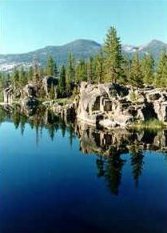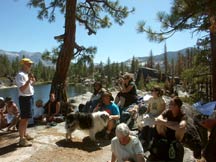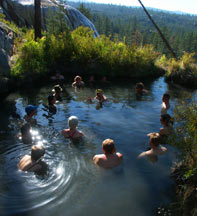
The campground is first come / first serve in September, and is right on the south fork of the San Jaquin River

South fork of the San Jaquin River near camp.

Doris Lake, near camp, is a great swimming location we'll visit
PostTrip Photo Page (work in progress)
This weekend we're going revisit a spot I consider one of the jewels of the field astronomy locations - to the High Sierra at Mono Hot Springs. This is northeast of Fresno and is one of the nearer locations which can get us to the dark clean skies of the Sierra. It also is home to a delightful thermal hot spring complex which will allow us to study the gurglings of Mother Earth and talk about inner planet structure and evolution through total immersion (so to speak). This is the site of our Astro 28W course from a few years back, so please check the post-trip photos from that trip
Location (map)
Mono Hot Springs is above Lake Edison, northeast of Fresno and deep into the high country. Directions are on the map on the Astro 28W site. It's at 6,500 ft elevation and has extremely dark skies. We'll be there on the last weekend of September, after the mosquito season is over, after the families and their kids are back in school, and before the cold weather arrives. For google Earth or GPs fans, the coordinates are: Long=119.016W, Lat=37.326N. As we get close to our weekend, here's the Weather Underground site to check on the latest weather forecast.
The campground is first come / first serve in September, and is right on the south fork of the San Jaquin River |
South fork of the San Jaquin River near camp. |
Doris Lake, near camp, is a great swimming location we'll visit |
July 15 - Saturday
9:00am-noon in room 705: Pre-trip meeting on campus to cover carpooling, liability waviers, meal planning, hand out maps, and lecture on the solar system.
July 21 - Friday
5:00pm: or as soon as you can arrive. Meet at the campground at Mono Hot Springs. The campsite next to the river will be our central site for the kitchen and campfire micro-lectures. We'll start on dinner as soon as the College van with our assistants. Then telescope explorations of the summer Milky Way's star formation regions, star clusters, globular clusters, nebulae, and stages of stellar evolution. And astrophotography demonstration.
July 22 - Saturday
8:00 am: French Crepes breakfast I'll prepare for you, and you can help with carving up fruit!
10:30am: Hike to (3 miles round trip) Doris Lake and have micro-lectures along the way on the formation of the chemical elements in stars, stellar evolution
3:00pm: Return to camp, and head out to Eden Hot Springs (about 1 mile) and lecture on cosmology while we enjoy the incredible views and warm water
6:30pm: Return to camp, start on dinner (Asian veges a'la Nolthenius!)
8:30pm-11:30pm: Telescope study of more deep sky objects, including galaxies and galaxy evolution. If cloudy, we'll lecture on the formation of the Universe around the campfire
July 23 - Sunday
8:00am: Breakfast of pan-fried veges and eggs with toast
9:30am: Hike to one of the hot springs just across the river, maybe 1/4 mile, to do our final lectures
11:00am: End of class; Pack up and head back over Kaiser Pass and to home. You should be home well before dark.
Instructor Office Hours: (always reliable to reach me by email as well, see my Salsa page)
July 15 Saturday 12 noon - 1:30pm in room 706
July 20 Thursday 3-4:30pm at the Observatory
Aug 3 Fri 4:50pm 8:15pm in room 706
July is the ideal time to study the star fields and nebulae of the summer Milky Way. This is the region which contains the center of our galaxy and is home to over 100 thousand million stars. The constellations of Sagittarius, Scorpius, Aquila and Cygnus contain some of the finest deep sky objects in the sky, strewn across the Sagittarius spiral arm of our galaxy about 5 kiloparsecs inside the sun's orbit around the Galaxy. We'll study the Eagle Nebula, the Lagoon Nebula, the North America Nebula, the beautiful supernova remnant known as the Veil Nebula, and a large collection of open star clusters and globular star clusters. All of these objects I've captured in digital photographs which you can see here.
I'd like to do an astrophotography demonstration as well. Our Nikon D7000 will be used with the Williams Optics GTF81 APO refractor for some nice series of images. Those of you with DSLR cameras, bring them along and I'll help you get some star trails and great reflection shots off the river next to camp.
The Occultation by the Asteroid Freia
There is a possible occultation of a faint star by the even fainter asteroid Freia, on Saturday evening at 11:04pm, which is a nicely convenient time for trying to videorecord. The star is extremely faint, only magnitude 12.8 and won't be visible visually except by a skilled observer with a good 12" scope, and maybe not even then, since a note in the prediction sheet indicates the uncertainty in the brightness, perhaps being fainter than 13th magnitude. So, it'll be a mystery waiting to be solved! Is the star to be occulted really at a brightness of magnitude 12.8, or is it much fainter? Is it a variable star? A defect on the UCAC4 image plate? We'll give you all the opportunity to watch science in action. Doing science means confronting a question and not being sure what the answer will be. It will be instructive to see and participate in the setup and attempt to video-record this event, even if it is a miss, from our campground site. The equipment I'll bring along include the 8" LX200gps telescope, Canon ZR45mc camcorder as recording device, Watec 910hx high sensitivity videocam, and the IOTA VTI video time inserter which inserts digitally the exact time to 1/1000 of a second, off GPS satellite transmissions
Planetary Science
We'll also study the planets: In
the evening, there's a beautiful views of Jupiter near
the brilliant blue giant star Spica all in central Virgo and setting over the
mountain soon after sunset. J
The slender cresent moon will be in the morning sky if you choose to get up early, rising during morning dawn. 
 During
the day, we'll take short hikes to study the many and varied springs collectively
known as Mono
Hot Springs by a direct first-hand immersive experience! We'll
hike to Doris Lake and the thermal springs which feed it, study the granite
domes and paint the story of the glaciations which formed them, and have in-the-field
lectures along the way. These lectures will cover the structure of the inner
planets of our solar system, what conditions are needed in order for a planet
to have plate tectonics, contrasting with plates on the Jupiter moon Europa, and the lack of plate tectonics on the other inner planets.
During
the day, we'll take short hikes to study the many and varied springs collectively
known as Mono
Hot Springs by a direct first-hand immersive experience! We'll
hike to Doris Lake and the thermal springs which feed it, study the granite
domes and paint the story of the glaciations which formed them, and have in-the-field
lectures along the way. These lectures will cover the structure of the inner
planets of our solar system, what conditions are needed in order for a planet
to have plate tectonics, contrasting with plates on the Jupiter moon Europa, and the lack of plate tectonics on the other inner planets.
Summary of The Plan
Friday evening you'll carpool your way to the campground. Hopefully we'll have an early bird who can grab a few campsites for us. I'll fix a dinner of delicious carbs, then we'll break out the telescopes and study the stars and planets. Bring snacks and chocolate chip cookies (our instructor's weakness) to power us through the crisp evening temperatures. Saturday morning I'll get up early and prep our special breakfast - French Crepes! We'll have a leisurely feed, then hike to Doris Lake. We'll have stops along the way and especially at a beautiful overlook above the lake for micro-lectures on all things geological and planetary. Then we'll enjoy some relaxation time swimming and making vitamin D (i.e. sunning) on the sun-baked Sierra granite around the lake shore. Then lunch and an afternoon hike up to Eden hot springs perched high above in the cliffs across the river, where I'll lecture on hot springs formation and the controversial evidence for springs on Mars. Before sunset, I'll cook dinner, with some volunteer help. Saturday night we'll do more observing, focusing on the evening planets before looking deep to the galaxy clusters of Leo and Virgo, as well as star formation regions of the Sagittarius Spiral Arm of our Galaxy. By midnight I expect only the last hardy souls will still be observing. Sunday morning breakfast will be eggs and veges panfried, with spices. Then a quick final lecture and hot springs soak just across the river a few minutes walk from camp.
Your grades will be based on class participation and enthusiasm, and also on your take-home final exam which you'll mail in to me within 2 weeks of our return. Take note - these classes are important to me, and to the Astronomy program. It's important that I do everything I can to encourage participation by good students who will be responsible. Grading will therefore have some subjective component - a helpful attitude around the group work loads, a willingness to listen to the lectures and participate in the discussions, no swearing, and a strict adherence to the Cabrillo policy of no drugs or alcohol. Details of course grading are at the link to the main Astro 25 page above. These classes are always a lot of fun - we blend learning with enjoyment and this makes for the maximum educational impact.. Join us!
Link to the PowerPoint I gave at the Pre-Trip Meeting and the .pdf version